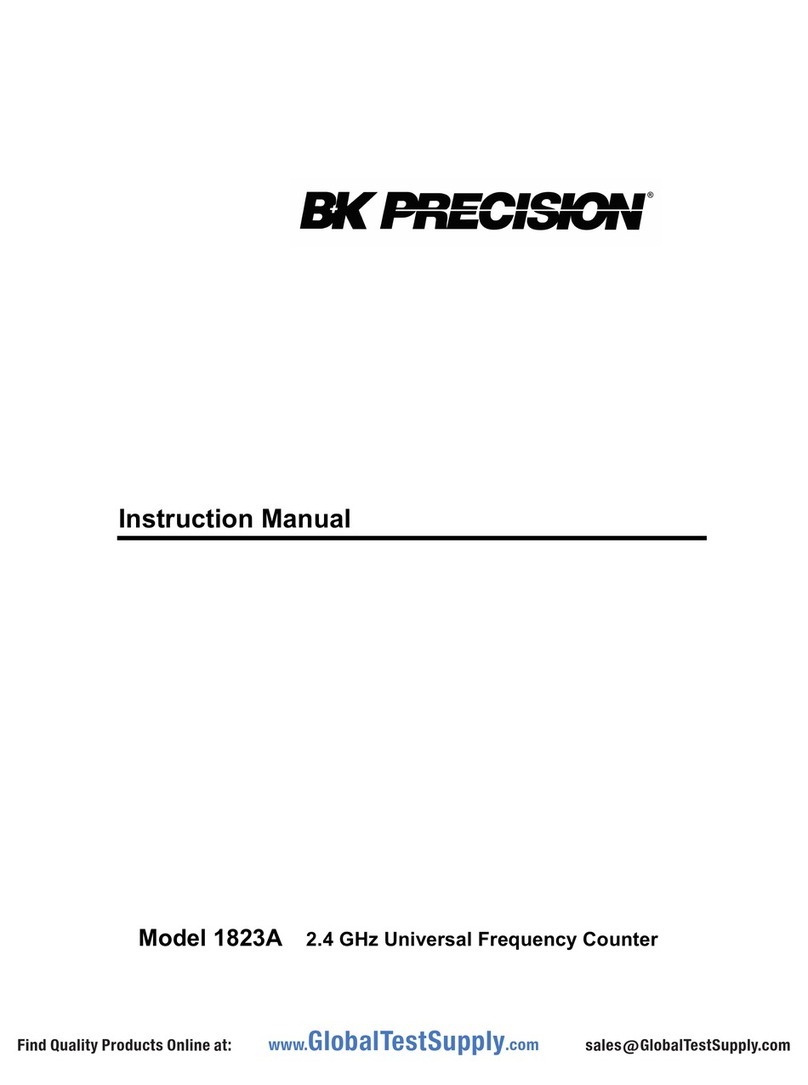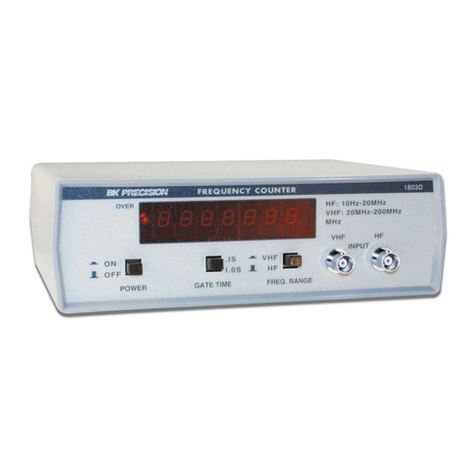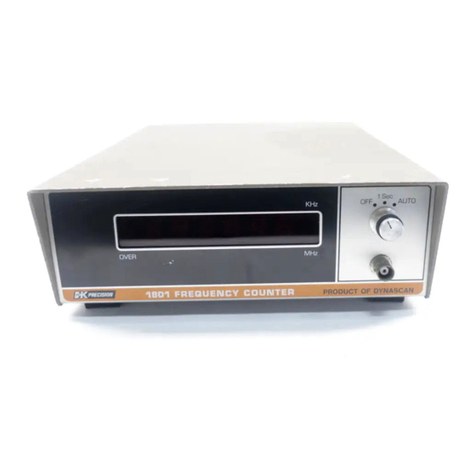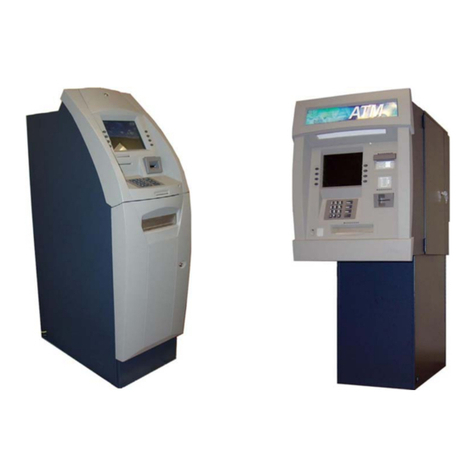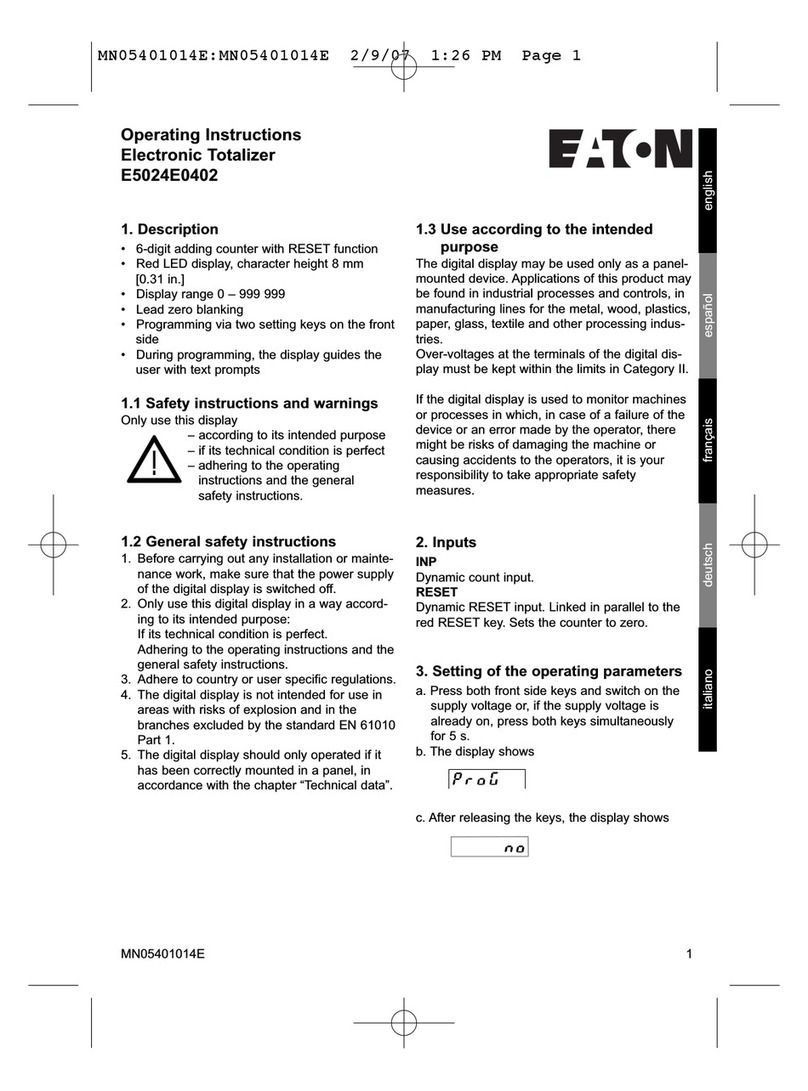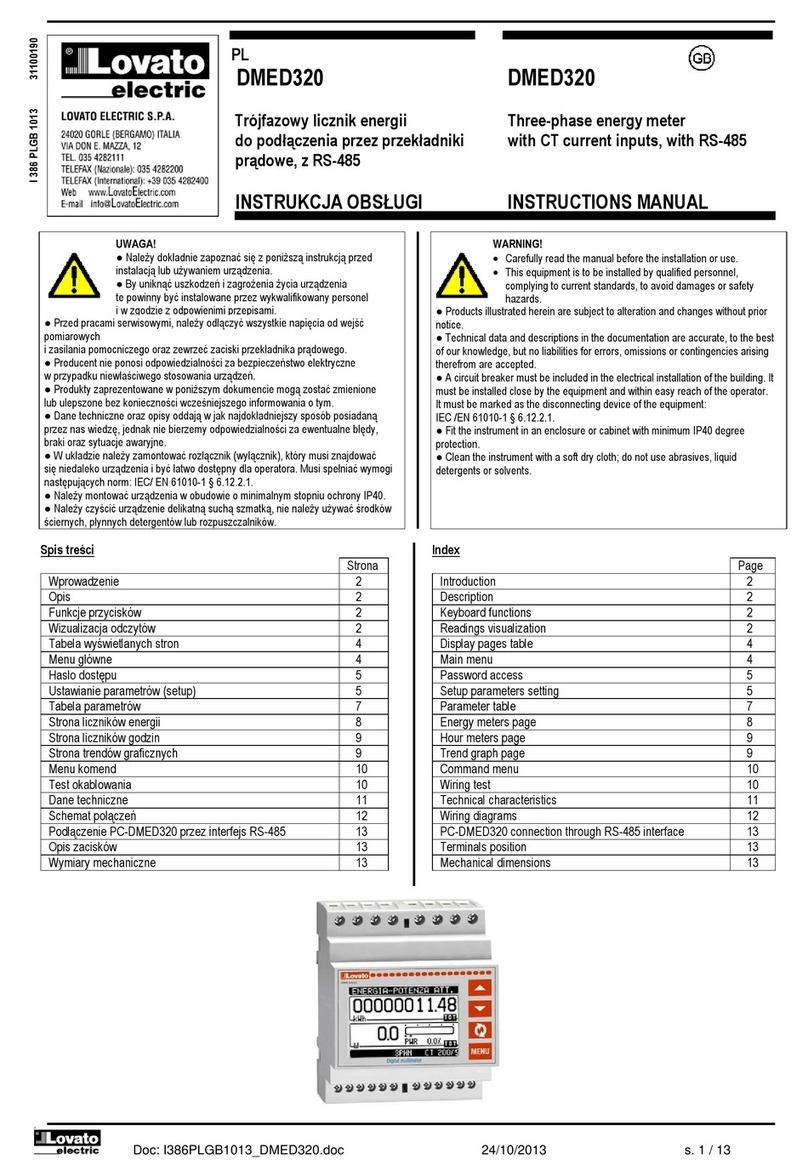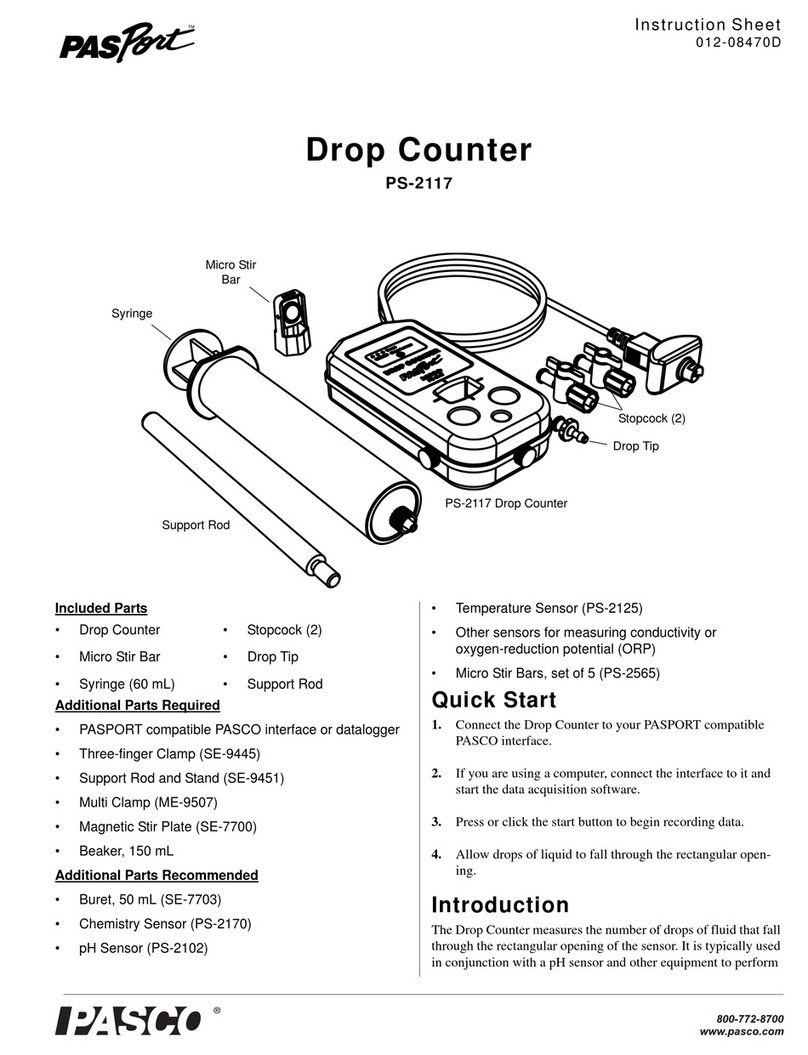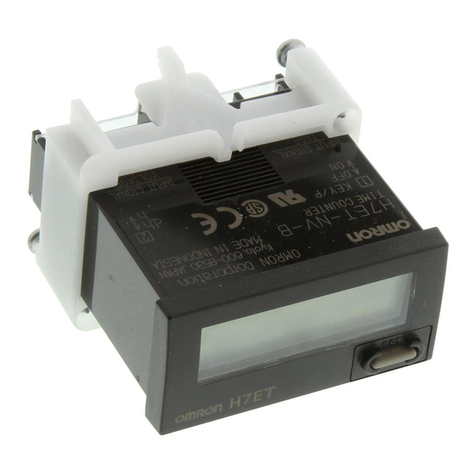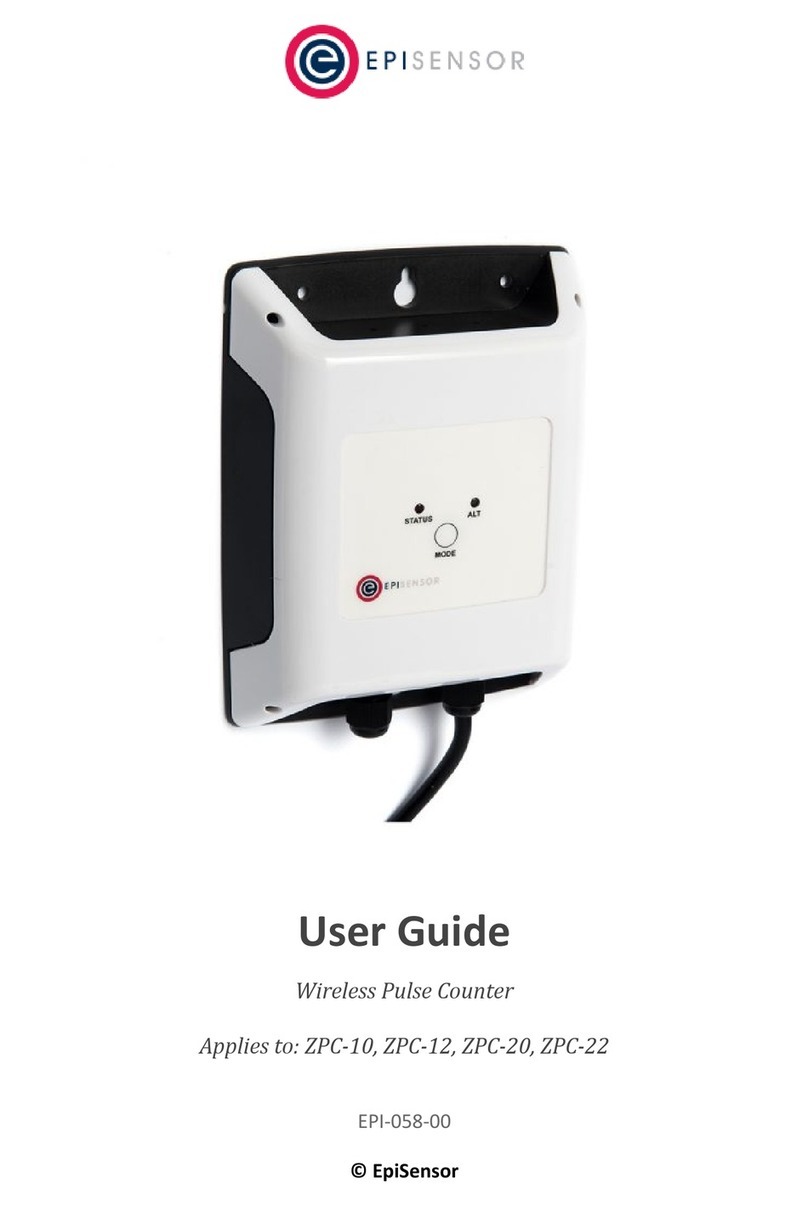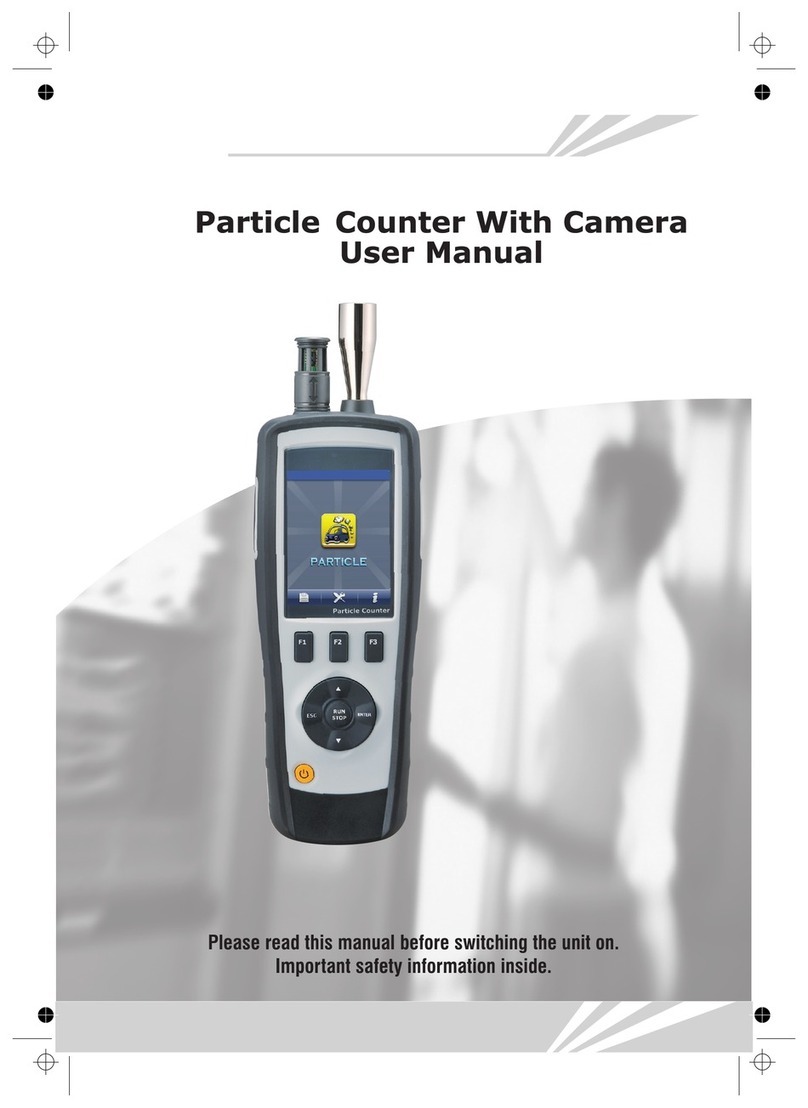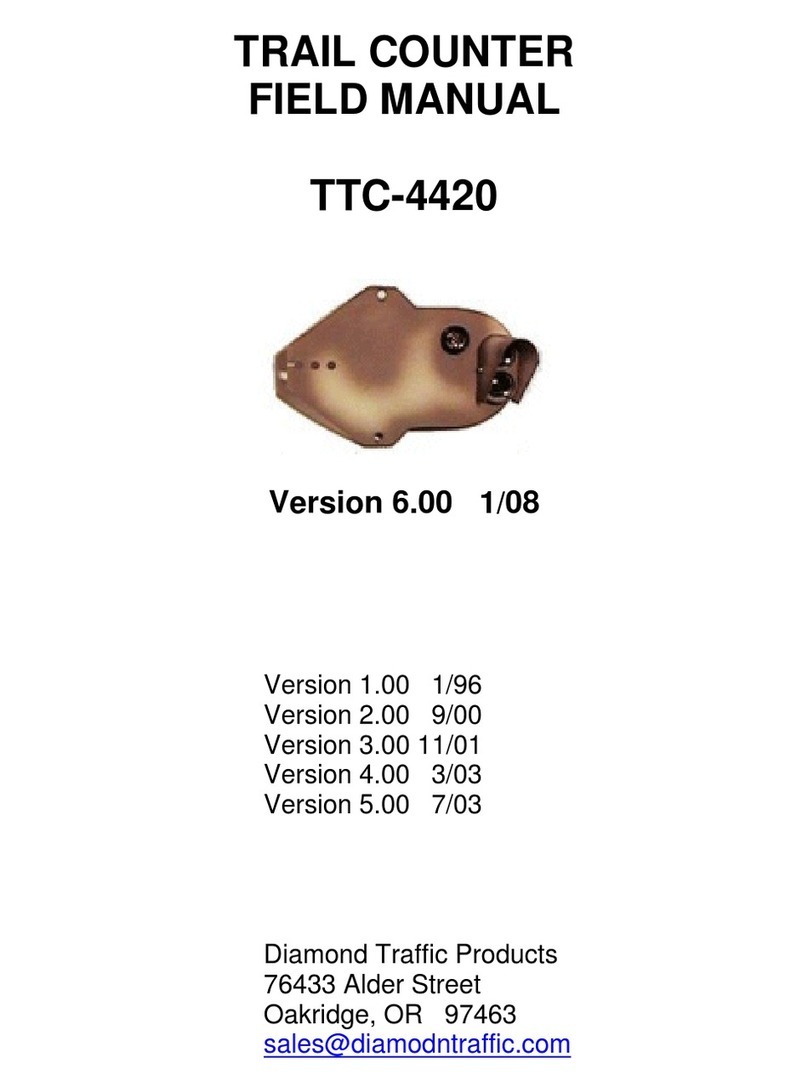B+K precision 1804D User manual

INSTRUCTION
MANUAL
MANUAL DE INSTRUCCIONES Model 1804D
Modelo 1804D
1G
Hz FREQUENCY
COUNTER
1GHz CONTADOR DE
FRECUENCIA

2
TEST INSTRUMENT SAFETY
WARNING
Normal use of test equipment exposes you to a certain amount of danger from electrical shock because testing must sometimes be performed
where exposed voltage is present. An electrical shock causing 10 milliamps of current to pass through the heart will stop most human
heartbeats. Voltage as low as 35 volts dc or ac rms should be considered dangerous and hazardous since it can produce a lethal current under
certain conditions. Higher voltages pose an even greater threat because such voltage can more easily produce a lethal current. Your normal
work habits should include all accepted practices to prevent contact with exposed high voltage, and to steer current away from your heart in
case of accidental contact with a high voltage. You will significantly reduce the risk factor if you know and observe the following safety
precautions:
1. Don't expose high voltage needlessly. Remove housings and covers only when necessary. Turn off equipment while making test
connections in high-voltage circuits. Discharge high-voltage capacitors after removing power.
2. If possible, familiarize yourself with the equipment being tested and the location of its high voltage points. However, remember that high
voltage may appear at unexpected points in defective equipment.
3. Use an insulated floor material or a large, insulated floor mat to stand on, and an insulated work surface on which to place equipment; and
make certain such surfaces are not damp or wet.
4. Use the time proven "one hand in the pocket" technique while handling an instrument probe. Be particularly careful to avoid contacting a
nearby metal object that could provide a good ground return path.
5. When testing ac powered equipment, remember that ac line voltage is usually present on some power input circuits such as the on-off
switch, fuses, power transformer, etc. any time the equipment is connected to an ac outlet, even if the equipment is turned off.
(continued on inside back cover)

3
TABLE OF CONTENTS
page
TEST INSTRUMENT SAFETY...........inside front cover
SPECIFICATIONS........................................................4
CONTROLS AND INDICATORS ...............................6
OPERATING INSTRUCTIONS ................................... 8
page
Instrument Repair Service ........................................... 10
LIMITED ONE-YEAR WARRANTY ........................11
SPANISH MANUAL................................................... 13

4
SPECIFICATIONS
MODES/FEATURES
Gate Times ----- 1.0 sec and 0.1 sec gates.
Display----------- 8 digits
FREQUENCY CHARACTERISTICS
Frequency Range
HF 10Hz to 10MHz
VHF 10MHz to 1000MHz
Accuracy1.0 sec gate ± Time base accuracy +1 count
0.1 sec. gate. ±Time base accuracy +2 count
Input connectors BNC
Resolution:
1.0 Sec Gate ............ 1Hz
0.1 Sec Gate ........... 10Hz
INPUT CHARACTERISTICS
IMPEDANCE .................HF 1 MΩVHF 50Ω
Connector.........................BNC
Coupling ..........................D6
Sinewave Sensitivity......50mVrms, 10Hz to 200MHz
Maximum Input .............. 3V
TIME BASE CHARACTERISTICS
Type .................................Crystal Oscillator
Frequency ....................5.24288MHz
Stability .......................±l0ppm
Temperature Stability....≤0.001%(10ppm),0-50°C
Maximum Aging Rate ..±10ppm/year

5
SPECIFICATIONS
NOTE: Specifications and information are subject to change without notice. Please visit www.bkprecision.com for the most current product
information.
Input Impedance:
HF : .................................1MΩ
VIE:..................................50MΩ
Input Voltage: .................................50mV Nominal, 3V
Maximum
Gate Times: ..................................0.1 sec. 1 sec.
Definition:......................................HF 1Hz/VHF 10Hz
Operating Temperature:..............0 to 40C°
Power Supply: ..............................7- 10V, 800mA
Input Sensitivity: ..........................50mV (10Hz to 200MHz)
DISPLAY CHARACTERISTICS
Display .................................0.43” LED’s
Overflow Indicator OVER (top left corner of display)
Display Update Time ............1.0 sec Gate: 2.0 seconds.
0.1 Sec Gate: 0.2 seconds.
GENERAL
Power:
AC Adapter .................. 7-10V with 800mA
Temperature Range & Humidity:
Operation 0 to =50°C, ≤
85%R.H.
Storage -15°C to +70°C,
≤75%R.H.
Dimensions(H x W x D) 2.1” X 9.05” X
6.18” (54 X 230
X 157mm)
Weight 0.8Kgs (1.751 lbs)
Accessories Supplied ............ Instruction Manual
BNC to Clip Cable

6
CONTROLS & INDICATORS
1. Input Jack. Input jack for 10Hz to 1000MHz frequency measurements
2. Display. Seven digit display used for all frequency readings
3. Frequency Function Switch. Selects VHF and HF frequency range at input jack.
4. Gate Time Switch. Selects gate time 0.1 second and 1.0 second
5. POWER Switch. Turns power ON and OFF.

7
CONTROLS & INDICATORS

8
OPERATING INSTRUCTIONS
WARNING
Some operating conditions may pose an electrical shock
hazard. Know and observe the precautions described in the
"Test Instrument Safety” section.
1. Connect the AC Adapter to an ac outlet and plug into the
rear panel jack of the frequency counter.
2. Set the POWER/GATE TIME switch to 0.1S or 1.0 S.
a. Use 0.1S for faster measurement of high
frequency signals. The update time of the
display is every 0.2 second. Resolution is 10Hz.
b. Use 1.0S for measurement of low frequencies or
where highest resolution is needed. The update
time of the display is every 2 seconds.
Resolution is 1Hz.
3. Apply the 10Hz to 1000MHz signals to be measured to the
input jack.
CAUTION
To prevent damage to the unit, do not apply input voltage higher
that the limits listed in the "Specifications” section. Connect the
instrument ground lead only to zero volt points in the circuitunder
test. Attempting to "float” the unit may result in a shock hazard,
since the instrument ground is exposed at the front panel BNC
connector. If measuring ac line frequency, observe the
precautions listed in the "Line Voltage Measurement" paragraph.
4. Frequency is given b the front panel display. The decimal
point is automatically positioned.
a. With a 1.0S gate time, readings below 1MHz are
given in decimal MHz, above 1MHz, they are in
whole megahertz. For example, 12KHz is
displayed as.012000, and 12MHz is 12.000000.
b. With a 0.1S gate time, all readings are displayed
in MHz, and with oneless digit resolution. For
example, 12KHz is displayed as 0.01200, and
12MHzis 12.000000.
5. Measurement interval, or "gate time", is 1.0 second or 0. I
second. This is combined with an additional interval of equal
time for internal latching and resetting, for a total of 2
seconds between display updated when 1.OS gatetime is
selected or 0.2 seconds when 0.1S gate time is selected.

9
CONSIDERATIONS
Display Instability
An uncertainty of ± I least significant digit is inherent in all
digital measurements, and greater uncertainties can result
from other factors. For example, in low frequency
measurements, high frequency noise on the input can cause
miscounting. Also, uncertainty may be introduced by
instability of the input frequency, usually common with LC -
type oscillators.
Use of Antenna
To measure transmitter frequency, it is not always necessary
to have a direct electrical connection to the transmitter. In
fact, the counter should be protected against from excessive
power levels. A preferred method of frequency measurement
is to connect an antenna to the input of the counter. The BK
Precision Model AT - 21 Antenna Kit is ideal for use with
the Model 1804D counter for measuring frequencies from
20MHz to 200MHz. The antenna should be placed in
parallel with the transmitting antenna and separate by a few
inches. The specific
distance is determined by the power level of the transmitter.
Some very low power transmitters may not provide enough
signal to the counter with this this method. An unmodulated
carrier should be transmitted and the frequency will appear
on the display of the counter.
Cable Considerations
Cable connections in RF measurements should be aimed at
reducing standing waves and shunt cable capacitance, both
of which can affect measurement accuracy.
Standing waves can be minimized by matching impedances
of signal source, cable, and termination. For example, for a
50 ohm source, use a 50 ohm cable and terminate with a 50
ohm,resistive load. Both standing waves and shunt cable
capacitance can be reduced by keeping cable lengths short,
under three feet (91cm).

10
Service Information
Warranty Service: Please return the product in the original packaging with proof of purchase to the address below. Clearly state in writing the
performance problem and return any leads, probes, connectors and accessories that you are using with the device.
Non-Warranty Service: Return the product in the original packaging to the address below. Clearly state in writing the performance problem and
return any leads, probes, connectors and accessories that you are using with the device. Customers not on open account must include payment in the
form of a money order or credit card. For the most current repair charges please visit www.bkprecision.com and click on “service/repair”.
Return all merchandise to B&K Precision Corp. with pre-paid shipping. The flat-rate repair charge for Non-Warranty Service does not include return
shipping. Return shipping to locations in North American is included for Warranty Service. For overnight shipments and non-North American
shipping fees please contact B&K Precision Corp.
B&K Precision Corp.
22820 Savi Ranch Parkway
Yorba Linda, CA 92887
www.bkprecision.com
714-921-9095
Include with the returned instrument your complete return shipping address, contact name, phone number and description of problem.

11
Limited One-Year Warranty
B&K Precision Corp. warrants to the original purchaser that its products and the component parts thereof, will be free from defects in workmanship
and materials for a period of one year from date of purchase.
B&K Precision Corp. will, without charge, repair or replace, at its option, defective product or component parts. Returned product must be
accompanied by proof of the purchase date in the form of a sales receipt.
To obtain warranty coverage in the U.S.A., this product must be registered by completing a warranty registration form on www.bkprecision.com
within fifteen (15) days of purchase.
Exclusions: This warranty does not apply in the event of misuse or abuse of the product or as a result of unauthorized alterations or repairs.
The warranty is void if the serial number is altered, defaced or removed.
B&K Precision Corp. shall not be liable for any consequential damages, including without limitation damages resulting from loss of use. Some states
do not allow limitations of incidental or consequential damages. So the above limitation or exclusion may not apply to you.
This warranty gives you specific rights and you may have other rights, which vary from state-to-state.
B&K Precision Corp.
22820 Savi Ranch Parkway
Yorba Linda, CA 92887
www.bkprecision.com
714-921-9095

12
TEST INSTRUMENT SAFETY
(continued from inside front cover)
6. Some equipment with a two-wire ac power cord, including some with polarized power plugs, is the “hot chassis” type. This includes most
recent television receivers and audio equipment. A plastic or wooden cabinet insulates the chassis to protect the customer. When the
cabinet is removed for servicing, a serious shock hazard exists if the chassis is touched. Not only does this present a dangerous shock
hazard, but damage to test instruments or the equipment under test may result from connecting the ground lead of most test instruments to
a “hot chassis”. To test “hot chassis” equipment, always connect an isolation transformer between the ac outlet and the equipment under
test. The B+K Precision Model TR-110 or 1604 Isolation Transformer, or Model 1653 or 1655 AC Power Supply is suitable for most
applications. To be on the safe side, treat all two-wire ac equipment as “hot-chassis” unless you are sure it has an isolated chassis or an
earth ground chassis.
7. On test instruments or any equipment with a 3-wire ac power plug, use only a 3-wire outlet. This is a safety feature to keep the housing or
other exposed elements at earth ground.
8. Never work alone. Someone should be nearby to render aid if necessary. Training in CPR (cardio-pulmonary resuscitation) first aid is
highly recommended.

13
SEGURIDAD DEL INSTRUMENTO DE PRUEBA
PRECAUCIONES
El Uso normal de equipo de pruebalo expone a cierto riesgo de choque eléctrico cuando efectúa pruebas donde hay alto voltaje descubierto. Un
choque eléctrico que cause una corriente de 10 mili amperes a través del corazón pararía la mayoría de los corazones humanos. Un voltaje tan bajo
como de 35 volts DC o AC rms podría considerarse de peligro porque puede producir una corriente letal bajo ciertas condiciones. Voltajes mayores
pueden ser aun más peligrosos. Sus hábitos normales de trabajo deben de incluir todas las prácticas aceptadas para prevenir descargas de alto voltaje,
y desviar la corriente lejos del corazón en caso de contacto accidental con un alto voltaje. Puede reducir el factor de riesgo significativamente si
observa las siguientes medidas de seguridad:
1. No se exponga a altos voltajes sin necesidad. Remueva la caja y tapas solo cuando sea necesario. Apague el equipo cuando haga conexiones de
prueba en circuitos de alto voltaje. Descargue los capacitores de alto voltaje después de apagar.
2. Si es posible, familiarícese usted mismo con el equipo por revisar y la localización de los puntos de alto voltaje. Considere, sin embargo, que un
voltaje alto puede aparecer en puntos inesperados en equipo defectuoso.
3. Use un piso de material aislante o un tapete aislante largo para situarse, y una superficie de trabajo aislante en la cual pueda poner el equipo;
asegúrese que las superficies no estén húmedas o mojadas.
4. Use la probada técnica de mantener “una mano en la bolsa” cuando este usando una sonda o punta de prueba del instrumento. Evite con particular
cuidado tocar un objeto metálico que pueda proveer un buen retorno a tierra.
5. Cuando revise un equipo conectado a voltaje de AC, recuerde que el voltaje está usualmente presente en algunos circuitos de entrada tal como el
switch de encendido y apagado, fusibles, transformadores de poder, etc. mientras el equipo esté enchufado a una toma de AC aun aún cuando
esté apagado. (continuó la cubierta de espalda)
INSTRUCTION
MANUAL
MANUAL DE INSTRUCCIONES Model 1804D
Modelo 1804D

14
TABLA DE CONTENDIDO
PÁGINA
SEGURIDAD DEL INSTRUMENTO…Segunda de forros
ESPECIFICACIONES................................................. 15
CONTROLES E INDICADORES .............................. 17
INSTRUCCIONES DE OPERACION ........................ 19
PAGINA
INFORMACION DE SERVICIO ................................21
GARANTIA LIMITADA DE UN AÑO .....................22

15
ESPECIFICACIONES
MODOS/CARACTERISTICAS
Tiempo de compuerta 1.0 seg y 0.1 seg.
Pantalla ---------- 7 digits
CARACTERISTICAS DE FRECUENCIA
Rango HF 10Hz a 10MHz
VHF 10MHz a 200MHz
Precisión 1.0 U seg gate ± Precisión base de tiempo +1
cuenta
0.1 sec. gate. ± Precisión base de tiempo +1
cuenta
Conector de entrada BNC
Resolución:
1.0 Seg Gate ............ 1Hz
0.1 Seg Gate ........... 10Hz
INPUT CHARACTERISTICS
IMPEDANCIA ................HF 1 MΩVHF 50Ω
Conector...........................BNC
Acoplamiento .................D6
Sensitividad senoidal .....50mVrms, 10Hz to 200MHz
Entrada máxima ............. 3V
CARACTERISTICAS DE BASE DE TIEMPO
Tipo ..............................Oscilador de cristal
Frequencia ...................5.24288MHz
Estabilidad ...................±0.lppm
Estabilidad térmica........≤0.001%(10ppm),0-50°C
Envejecimiento máximo ±10ppm/year

16
SPECIFICATIONS
NOTA: Las especificaciones y la información están conforme a cambio sin el aviso de B&K Precision Corp. Por favor visite www.bkprecision.com
para las especificaciones más corriente y información de nuestros productos.
Impedancia de entrada:
HF : .................................1MΩ
VIE:..................................50MΩ
Voltaje entrada:.. 50mV Nominal, 3V
Tiempos de compueta: ................ 0.1
segsec. I sec.
Definicion: .....................................HF 1Hz/VHF 10Hz
Temperatura operación: ..............0 to 40C°
Fuente de poder: ..........................7- 10V, 800mA
Sensitividad de entrada: ..............50mV (10Hz to 200MHz)
CARACTERISTICAS DE PANTALLA
Pantalla .................................0.43” LED’s
Indicador de sobreflujo esquina superior izquierda
Actualización de pantalla .....1.0 sec Gate: 2.0 seconds.
0.1 Sec Gate: 0.2 seconds.
GENERAL
Potencia
Adaptador AC ...................... 7-10V con 800mA
Rango de temperature y humedad:
Operacion 0 to =50°C, ≤
85%R.H.
Almacenamiento -15°C to +70°C,
≤75%R.H.
Dimensiones(H x W x D) 2.1” X 9.05” X
6.18” (54 X 230
X 157mm)
Peso 0.8Kgs (1.751
lbs)
Accesorios incluídos............. Manual
Cable BNC a clip

17
CONTROLES E INDICADORES
1. Jack de entrada. Jack de entrada para mediciones de frecuencia de 10Hz to 1000MHz.
2. Pantalla.Display de 7 dígitos para todas las frecuencias.
3. Switch de función de frecuencia.: Seleccciona rango de frecuencia VHF y HF en el jack
de entrada.
4. Switch de tiempo de compuerta.: Seleccciona tiempo de 0.1 segundos y 1.0 segundos
5. Switch POWER : Encendido ON y OFF. .

18

19
INSTRUCCIONES DE OPERACION
ADVERTENCIA
Algunas condiciones de operación pueden producir un riesgo
de choque eléctrico. Conozca y observe las precauciones
descritas en la sección "Seguridad del instrumento de prueba” .
4. Conecte el adaptador de AC a un enchufe AC e insértelo
en el jack del panel trasero del contador. De frecuencia.
5. Fije el POWER/GATE TIME switch a 0.1S o 1.0 S.
a. Use 0.1S para mediciones más rápidas de
señales de alta frecuencia. El tiempo de
actualización en pantalla es de 0.2 segundos. La
resolución es de 10Hz.
b. Use 1.0S para mediciones de frecuencias bajas
o para mayor resolución. El tiempo de
actualización es de 2 seg. La resolución es de
1Hz.
6. Aplique las señal a medir al jack de entrada.
PRECAUCION
Para prevenir daños a la unidad no aplique voltajes de entrada
superiores al límite establecido en la sección de
“Especificaciones”. Conecte la tierra del instrumento sólo a
puntos de cero voltas del circuito bajo prueba . No pretenda
“flotar” la unidad pues se genera un riesgo de dado que la tierra
del instrumento está expuesta en el conector frontal BNC. Al
medir la frecuencia de la línea de AC, observe las precauciones
enlistadas en el párrafo "Medición del voltaje de línea".
6. La frecuencia se muestra en pantalla. El punto decimal se
posiciona automáticamente
a. Con un tiempo de 0.1s, lecturas menores a 1MHz
se muestran décimas de MHz ; arriba de 1MHz, se
muestran en Mhz. Por ejemplo, 12KHz se muestra
como.012000, y 12MHz como 12.000000.
b. Con un tiempo de 0.1S, todas las lecturas son en
Mhz, con un dígito menos de resolución. Por
ejemplo, 12KHz se muestra como 0.01200, y
12MHz como 12.000000.
7. El intervalo de medición “tiempo de compuerta”, es 1.0 segs.
or 0. 1 seg. Este se combina con el intervalo adicional de
igual tiempo de reajuste interno para un total de 2 segundos
entre actualización de pantalla al seleccionar 1.0S o 0.2 segs.
al seleccionar tiempo de compuerta de 0.1 seg.

20
CONSIDERATIONES
Inestabilidad de
pantalla
Una inestabilidad de ± 1 dígito menos significativo es
inherente en todas las mediciones digitales,y pueden existir
incertidumbres a causa de otros factores, como el ruido de
alta frecuencia en mediciones de baja frecuencia, o
inestabilidad de la frecuencia de entrada común en
osciladores del tipo LC.
Uso de antena
Para medir frecuencia de transmisores, no es siempre
necesaria una conexión directa al transmisor.. De hecho, el
contador debe protegerse contra niveles excesivos de
potencia. Se prefiere el método de conectar una antenna a la
entrada del contador.. El BK Precision Model PT - 21
Antenna Kit es ideal para usarse con el Modelo I803d para
medir frecuencias de 20MHz a 200MHz. La antena debe
colocarse en paralelo con la antenna transmisora separada
por unas cuantas pulgadas.
La distancia específica se determina por el nivel de potencia
del transmisor. Algunos transmisores de muy baja potencia
pueden no proveer una señal suficiente para la medición con
este método.; se debe transmitir una portadora no modulada
y la frecuencia aparecerá en pantalla del contador.
Consideraciones de cable
Las conexiones de cables en mediciones de alta frecuencia
deben efectuarse para reducer ondas estacionarias y eliminar
capacitancia paralelo, las cuales afectan la precisión de la
medición.
Las ondas estacionarias se minimizan pareando la
impedancia de la fuente de entrada con la del cable y la
terminación. Por ejemplo, para una fuente de 50 ohms use
cable de 50 ohms y una carga terminal resistiva de 50 ohms.
Tanto las ondas estacionarias como l capacitancia paralelo
pueden reducirse con cables cortos, de menos de 3 pies,
(91cm).
Table of contents
Languages:
Other B+K precision Cash Counter manuals
Popular Cash Counter manuals by other brands
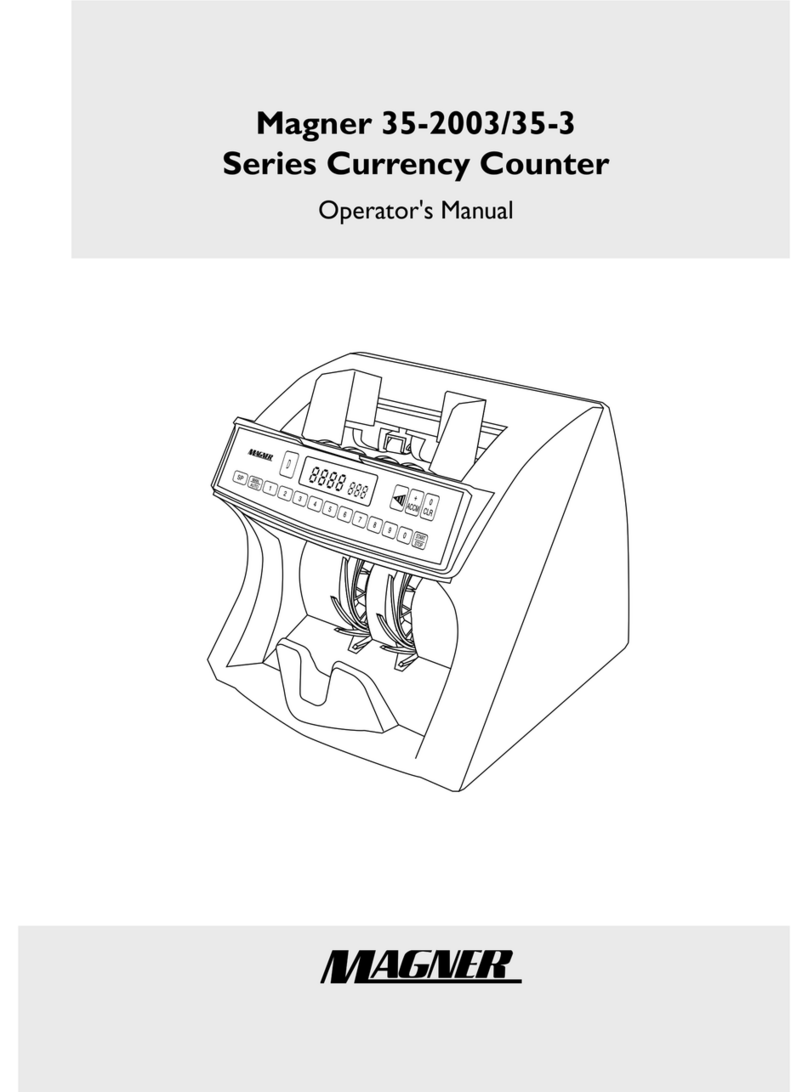
Magner
Magner 35-2003 Series Operator's manual

HP
HP 5305 B Operating and service manual
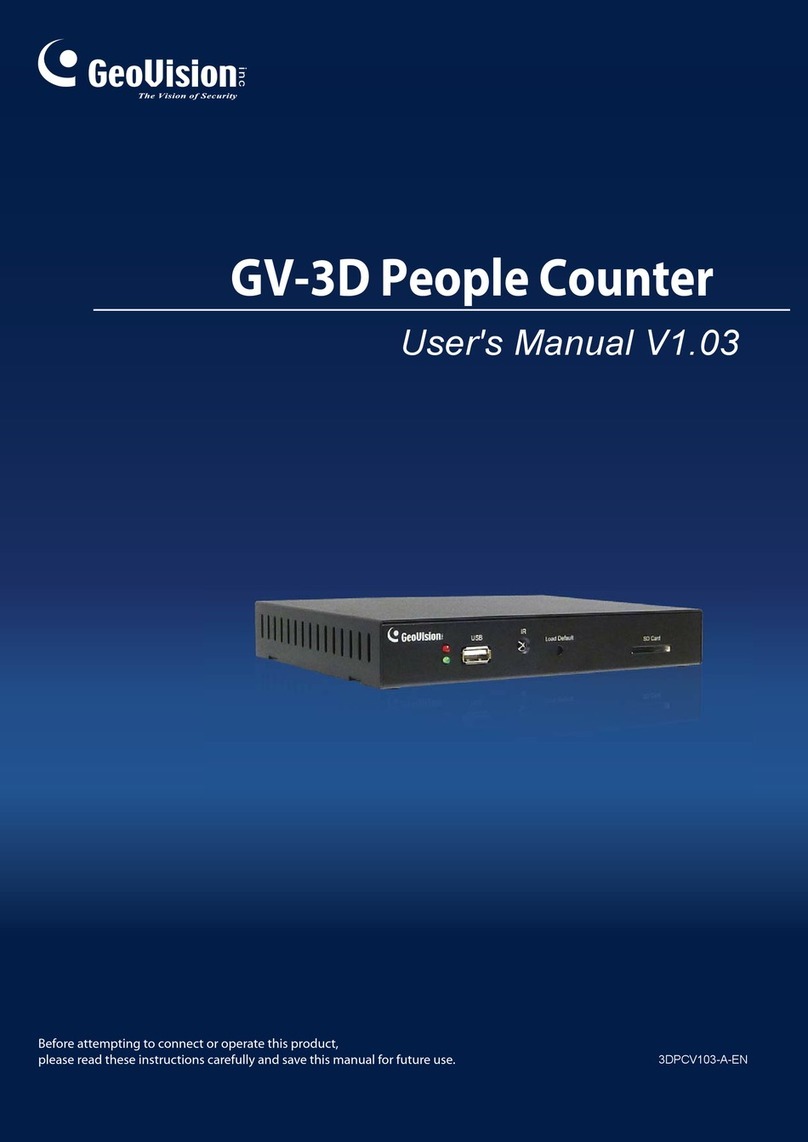
GeoVision
GeoVision GV-3D People Counter V2 user manual
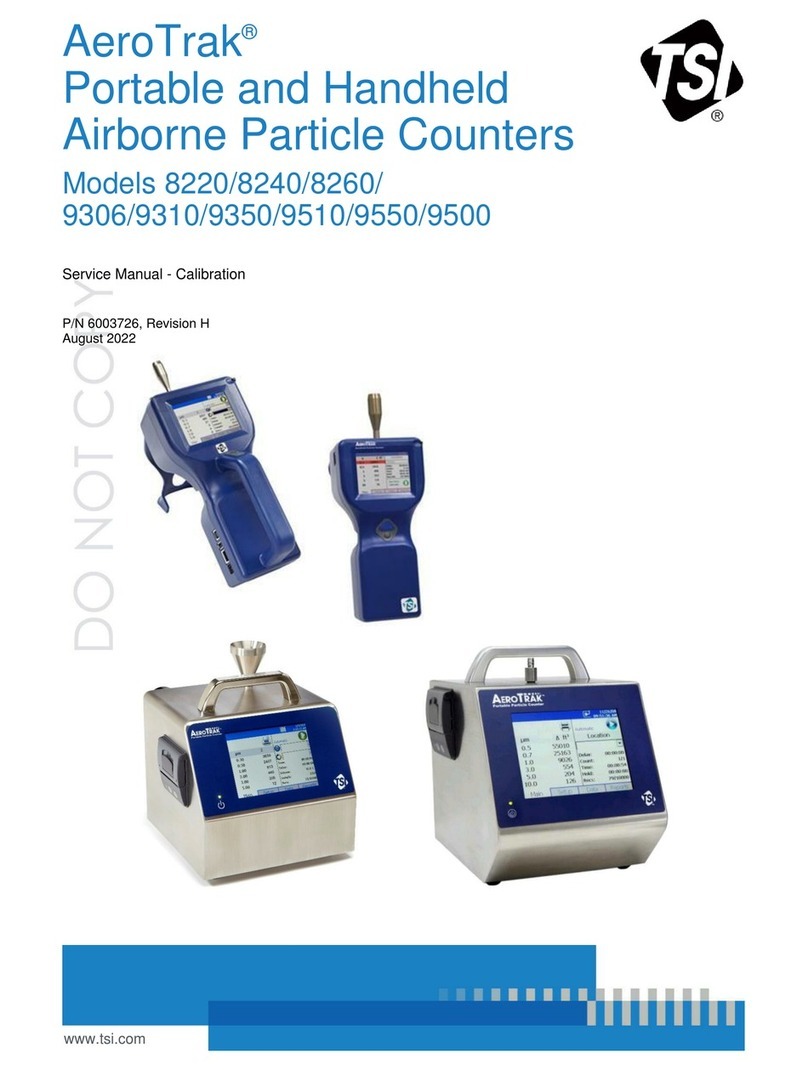
TSI Instruments
TSI Instruments AeroTrak 8220 Service manual

Diamond Traffic Products
Diamond Traffic Products Pegasus Quick installation guide

SINO
SINO SDS2-3MS Operation manual
